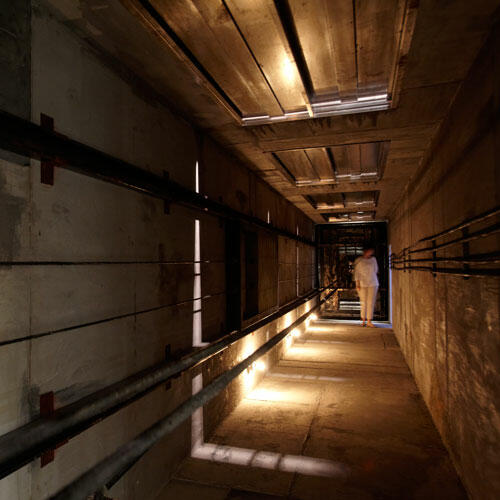Leandro Erlich
Sean Kelly, New York
The elevator is, in Leandro Erlich’s words, “a functional object, but in which life seems to be suspended between brackets. Recorded voices and music can step in to alleviate the inconveniences of the trip, but we cannot avoid each other in this space and consequently experience the Sartrean room of the ego. We are nobody, we are nowhere, we are not any person and we are not in any place”.

Like a music composer, Erlich creates for the show Two Different Tomorrows a series of variations on these, presenting scenes in which elevators, devoid of their function and context, highlight the narrative potential of the common. The result is monumental works with simple gestures. Each installation maintains the same harmonic pattern of the original theme, and each part associates itself with the other. Five installations of fluent spaces which fool the eye playing with perspective and other visual effects.
Erlich composes with uncertain architectures, creating apparently harmless narrative spaces of incredible cinematographic tension. The inspirations are varied and range from literature to cinema. Stuck Elevator is an elevator stuck between two floors and Elevator Pitch is a door of an elevator opening and closing which reveals a group of persons inside the elevator; they are perfect scenes by Alfred Hitchcock or David Lynch, who, according to Erlich, “have utilized the day by day as a scenario for the creation of a fictitious world obtained through psychological subversion in everyday spaces”.
In Elevator Shaft, the shaft of an elevator in a horizontal view and in Double Skylight (The Clouds Story) two skylights facing a blue sky, a little like Alfred Jarry, Erlich’s work is a study of reality which does not reside in the laws but rather in the exceptions to such laws. Elevator Maze, a labyrinth of elevator cabins, like in Jorge Luis Borges’ or Julio Cortázar’s literature, is a structure in which the spectator loses the perception of space and of the materials that surround him.
The artist plays with the mechanisms of the “ready made”, de contextualizing systems of contemporary architecture, subverting them to radical changes in their essential elements: up is down, inside is out. Through the subversion of these structures, the artist breaks the absolutes and the institutions that support them.
The playful element, the trompe l’oeuil, is just a means, a subordinate resource. Through his work, he opposes a world governed more or less harmoniously by a system of laws, of principles, of cause-effect relations, of defined psychologies, of well mapped geographies.
-
 Photograph/Fotografía Jason Wyche. Courtesy/Cortesía: Sean Kelly Gallery, New York.
Photograph/Fotografía Jason Wyche. Courtesy/Cortesía: Sean Kelly Gallery, New York.




